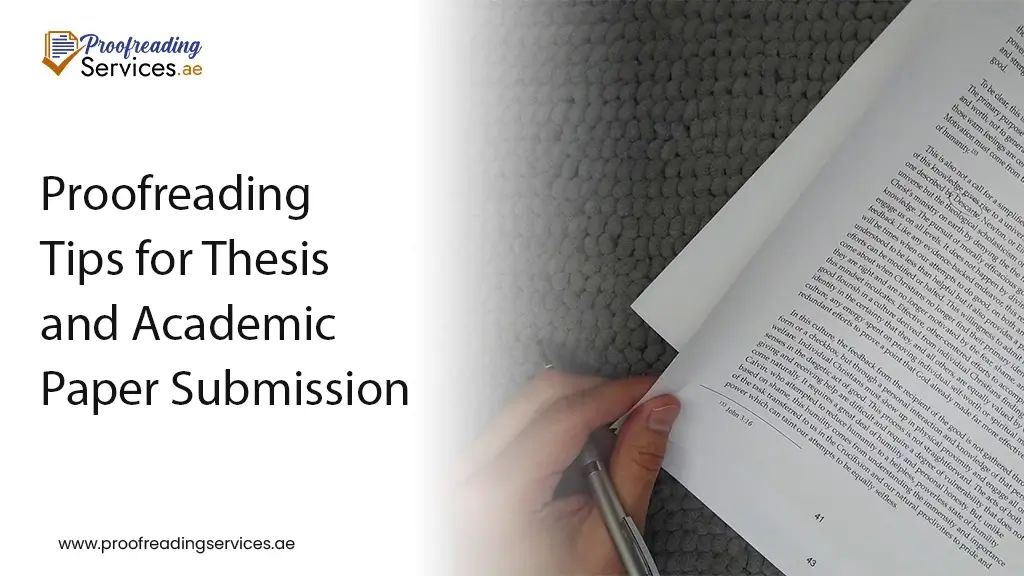Students! Would you happen to know? Studies often show students make many grammatical and punctuation errors. That makes them lose their grades!
In other words, grammar, spelling, and punctuation errors are a major cause of lower grades. Therefore, they need to learn to proofread their writings. It helps avoid these pitfalls by improving clarity, accuracy, and flow.
So, don’t wait! Learn 5 practical proofreading tips for your thesis and academic papers in this blog.
Read along!
Why Proofreading is Important for Academic Paper Submission
Picture this: You are putting in your best effort into your academic paper. You are dedicating days and nights to perfecting every aspect of your writing. However, you end up losing marks for the smallest punctuation errors. What a dreadful feeling that must be!
So, proofreading is vital for academic paper submissions for the following reasons:
- Catching grammar, punctuation, spelling, and sentence structure errors improves clarity.
- Correcting mistakes allows readers to see the strength and originality of your research.
- An error-free paper reflects professionalism and attention to detail. It boosts your grades and builds your academic integrity.
- Proofreading identifies typos and formatting inconsistencies that spell check tools may overlook.
Thus, proofreading is important for the consistent and error-free presentation of your paper. Now you know why proofreading is important before submission. It is time to move to the next section, where you will learn proofreading tips.
5 Practical Proofreading Tips for Thesis and Academic Paper Submission
Avengers, assemble! Your wait is over! You have reached the section you have been waiting to read. Hence, here are 5 practical proofreading tips for your thesis and academic papers. So you can defeat writing errors this time.
Wait, before you start learning proofreading tips. Let me share an extra pro tip waiting for you at the end of this section. So go on, read, and hold your shield tight!
1. Take a Break to Gain Fresh Eyes
Writing an academic paper takes time and effort. You sit in front of your laptop screen. Researching, structuring, writing, and formatting your paper. With each passing second, your eyes get redder and watery. Thus, you reach a moment when they start getting hurt, and you have to close them.
So, how can you identify errors in your writing with your tired eyes? It is impossible, and it is bad for your health. When you focus on one writing, you become too familiar with the text, so you cannot know what is wrong.
Therefore, a wise proofreading tip is to stay away from it for a few hours or even a full day. This will help you return with a fresh perspective. Thus, with fresh eyes, you can spot errors you might have missed.
But some writing errors can hide from your eyes. So, read on to find out how your voice can help in combating errors.
2. Read Your Paper Aloud
When you see writing errors hindering your compelling arguments.
Yes, the proofreading tip is to read your paper aloud. This forces your brain to slow down. So, it perceives text differently. This makes it easier for you to catch mistakes like:
- Missing words.
- Awkward phrasing.
- Repetitive sentences.
- Similar sentences.
So, the error that might go unnoticed in passive reading can be caught aloud. If you believe that all writing errors are mixed up, then the next proofreading tip is for you!
3. Focus on One Error Type at a Time
Do you know? Humans categorize things to make complex information easier to understand. So, don’t try to find every type of mistake in a single pass. Focus on one category of errors in each proofreading session.
For example, one pass could be for spelling and grammar. Do the next one for punctuation, and a third for consistent formatting and citation style.
Thus, this will help you ensure that you have corrected all errors. Yet, there is one more proofreading tip that can help gain clarity about your paper. Read on!
4. Use a Printout
We have already discussed how your eyes become tired while staring at the screen. Hence, proofreading the digital version of your academic paper can be painful.
So, printing your thesis on paper can make errors more apparent than they appear on a computer screen. The physical format allows you to concentrate on individual lines of text. Moreover, it highlights inconsistencies or mistakes that are often overlooked during digital proofreading.
Thus, a printout won’t hurt your eyes, and a paper in your hand can help in proofreading. But if your thesis is contrary to the guidelines of your institution. All proofreading will go to waste!
5. Check Against Institutional Guidelines
Yes, nothing is right if it is not on the right track. That is to say, with all your attention, review your institution’s guidelines about:
- Formatting (paper size, margins, line spacing, page numbering, and the title page)
- Citation (APA, MLA, or Chicago)
- Submission (deadline)
So, verify that your paper meets the requirements. This is a critical final step to ensure your paper is polished and ready for submission.
Pro Tip: Seek Help from Professional Proofreading Services
While proofreading your academic papers on your own is good. But professional Thesis Proofreading Services can elevate your writing to its highest standard. They have an expert team of editors and proofreaders who make your papers shine.
Let’s Sum Up
Students! It is time to avenge writing errors. With these 5 practical proofreading tips, you are all set to defeat the mistakes this time.
- Take a break before you start proofreading your paper.
- Read the document aloud to catch awkward phrasing.
- Proofread for one error type at a time to maintain focus.
- Print your paper to see the error on paper instead of a screen.
- Check for specific institutional requirements.
Thus, this will ensure that your thesis is polished and ready for submission.
